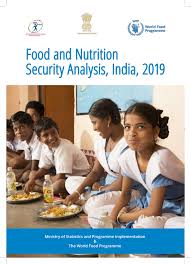Country’s food and nutrition security Report 2019 28/06/2019 – Posted in: Daily News – Tags: Sustainable development goal
COUNTRY’S FOOD AND NUTRITION SECURITY REPORT 2019
For: Preliminary & Mains
Topics covered: Highlights of the report, Sustainable development goal
News Flash
Almost one in three Indian children under five years will still be stunted by 2022 going by current trends, according to an analysis of the country’s food and nutrition security.
- Over the last decade, child stunting has reduced at a rate of about 1% per year.
- At this rate, 31.4% of children will still be stunted by the 2022 deadline.
The report, which is a baseline analysis of the country’s progress in achieving the second Sustainable Development Goal to end hunger, was prepared by the UN World Food Programme in collaboration with the Ministry of Statistics and Programme Implementation.
Highlights of Report
- Foodgrain yields have risen 33% over the last two decades, but are still only half of 2030 target yields.
- The Indian farmer is producing more foodgrains, but unfortunately, the consumer’s access to rice, wheat, and other cereals has not increased at the same rate, due to population growth, inequality, food wastage and losses, and exports.
- The average per capita consumption of energy among the poorest 30% of the population is 1811 kilo calories, much lower than the norm of 2155 kilo calories per day.
- In States like Bihar (48%) and Uttar Pradesh (46%), almost one in two children are stunted, while it is only one in five children in Kerala and Goa (20% each).
- There are high rates of stunting among children in the poorest wealth quintile (51.4%), Scheduled Tribes (43.6%) and Scheduled Castes (42.5%), and children born to mothers with no education (51%).
Sustainable Development Goal
India aims to end hunger by 2030, under its Sustainable Development Goal-2.
Targets
- By 2030, end hunger and ensure access by all people, in particular, the poor and people in vulnerable situations, including infants, to safe, nutritious and sufficient food all year round.
- By 2030, end all forms of malnutrition, including achieving, by 2025, the internationally agreed targets on stunting and wasting in children under 5 years of age, and address the nutritional needs of adolescent girls, pregnant and lactating women and older persons.
- By 2030, double the agricultural productivity and incomes of small-scale food producers, in particular women, indigenous peoples, family farmers, pastoralists and fishers, including through secure and equal access to land, other productive resources and inputs, knowledge, financial services, markets and opportunities for value addition and non-farm employment.
- By 2030, ensure sustainable food production systems and implement resilient agricultural practices that increase productivity and production, that help maintain ecosystems, that strengthen capacity for adaptation to climate change, extreme weather, drought, flooding, and other disasters and that progressively improve land and soil quality.
Source: The Hindu
You can follow us on LinkedIn and for more updates related to UPSC IAS Preparation, Like our Facebook Page and subscribe our Diligent IAS Youtube Channel
Also, Read Related Daily News
- United Nations Security Council- India’s Non-Permanent membership
- Improvised Explosive Devices – Components and Types
- National Register of Citizens
- Waste segregation systems in India
- Agro-ecological zones
- Narco-Terrorism
- Report on Magnitude of Substance abuse in India- 2019
- Payments related data to be stored only in India
- DNA Technology (Use and Application) Regulation Bill


